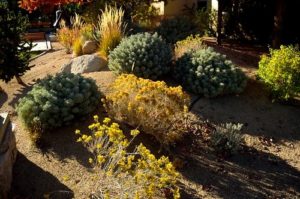Water may seem like an abundant and readily available resource for many homeowners. Yet, it’s far more precious than you may realize. Forty out of 50 state water managers expect to face a water shortage in some parts of their states over the next decade. Mindful use of this limited water supply is crucial, and the yard is a great place to begin. This is where xeriscaping comes in. This innovative landscaping solution offers a wealth of benefits for your budget and the environment.
What Is Xeriscaping?

Xeriscaping by Tom Hilton is licensed with CC BY 2.0.
Xeriscaping is a low-maintenance form of landscaping designed for dry regions that are susceptible to droughts. This type of landscape design minimizes or reduces the need for irrigation, creating a beautiful setting that’s not reliant upon a steady supply of water. Xeriscaped landscapes are typically homogenous with the surrounding environment, drawing on the natural plants and features of the area in a minimalist way that requires very little maintenance once installed.
Where Is Xeriscaping Used?
Xeriscaping is primarily used in dry parts of the western United States, such as California, Arizona, and Nevada. However, this type of landscaping isn’t exclusive to any one climate. Homeowners across the country can utilize the principles of xeriscaping to create beautiful, low-maintenance yards that reduce the strain on natural resources.
What Are the Benefits of Xeriscaping?
Xeriscaping offers a wealth of benefits. Though it takes some time and effort to transform your lawn into a xeriscaped paradise, you’ll enjoy long-term perks from this project.
Reduced Water Use
Xeriscaping is an outstanding option for promoting the mindful use of resources, such as water, a particularly precious resource in dry climates. The average American home uses a whopping 320 gallons of water each day. Roughly 30% of this is used outdoors to water gardens and lawns. Xeriscaping helps protect this precious resource by reducing water use by as much as 75%.
Less Expense
Xeriscaped lawns use considerably less fertilizer and pesticides if they require any at all. This means that you can eliminate not only the cost of water for your yard but also the cost of other supplies. In some communities, you may even get cash back for this home project. The Los Angeles County Waterworks District operates a Cash for Grass program that rewards residents with a rebate for replacing grass with drought-tolerant landscaping.
Minimal Maintenance
Xeriscaping is far less labor-intensive than other forms of landscaping. There’s no need to meticulously water, fertilize, and mow this type of yard. Since this landscaping relies on natural elements, it’s a favorite of local wildlife. Xeriscaped lawns are often frequented by butterflies and birds, naturally adding to the beauty and appeal of this type of yard. You’ll work less to attract these welcome visitors and enjoy a stunning landscape naturally suited to them.
Greater Home Value
Xeriscaping boosts curb appeal and increases your home’s value in most communities. Home buyers understand that owning a home comes with a wealth of new maintenance costs. A xeriscaped lawn minimizes some of these expenses by keeping lawn care down. This is a feature that can help your home fly off the market.
The Principles of Xeriscaping
Xeriscaping looks different in every climate but always follows the same core principles. Though this type of yard is most prevalent in arid regions where cacti abound, you can incorporate xeriscaping effectively even when there isn’t a cactus in sight. To create an effective xeriscaped area, consider these essential points.
Native Low-Water Plants
Xeriscaping relies heavily on native plants that thrive in the area with little to no extra care from homeowners. This may mean using cacti and desert flowers in dry climates like Arizona. However, a xeriscaped lawn in New England may feature forsythia, while Seattle homeowners would turn to ferns. Thoughtful placement of trees provides a shady space where it’s easier for plants to conserve moisture.
The grass is seldom used in xeriscaping because of its abundant water use. Wildflowers and other ground cover are a better option.
Water-Wise Design
Xeriscaped areas typically feature different zones. The shadiest spots represent the oasis zone and feature plants that use water most. These are often larger and taller, so they’re visible around the house, gazebo, or a grove of trees. Moving away from this central spot, plants become shorter and use less water. The transition zone in the center features plants that use minimal water. The xeric zone is the furthest out and often features mulch or gravel, so there’s no need for water.
Mindful Irrigation
Though xeriscaping uses minimal water, some irrigation helps establish this landscape. A drip irrigation system is the best option, as it waters the plants deeply. This encourages deeper root growth and will help establish a garden that may eventually function without watering.
How To Get Started
A local nursery is one of the best places to begin if you’re ready to start xeriscaping. This project requires comprehensive planning, so you shouldn’t pull up your lawn without charting out your plans to replace it. A knowledgeable nursery in your area can help you identify plants native to the area that will thrive with minimal water and care.
Draw up a plan of the area you’re working with and include all the vibrant features of a xeriscaped garden, including plants, mulch, gravel, and decorative elements, such as large rocks. Consider proper use of rainfall in the area as well. Directing the water through natural irrigation channels or actively collecting it is a great way to provide your plants with moisture using what comes from the sky.
If you’re intrigued by the idea of xeriscaping, you may want to add this to your wish list for your next home. Check out our gallery of home exteriors and start dreaming about the options for a stunning, low-water landscape for your space. Opting for a custom home design, you can incorporate features like this from the beginning, so you don’t have to redo your lawn dramatically in the future.
